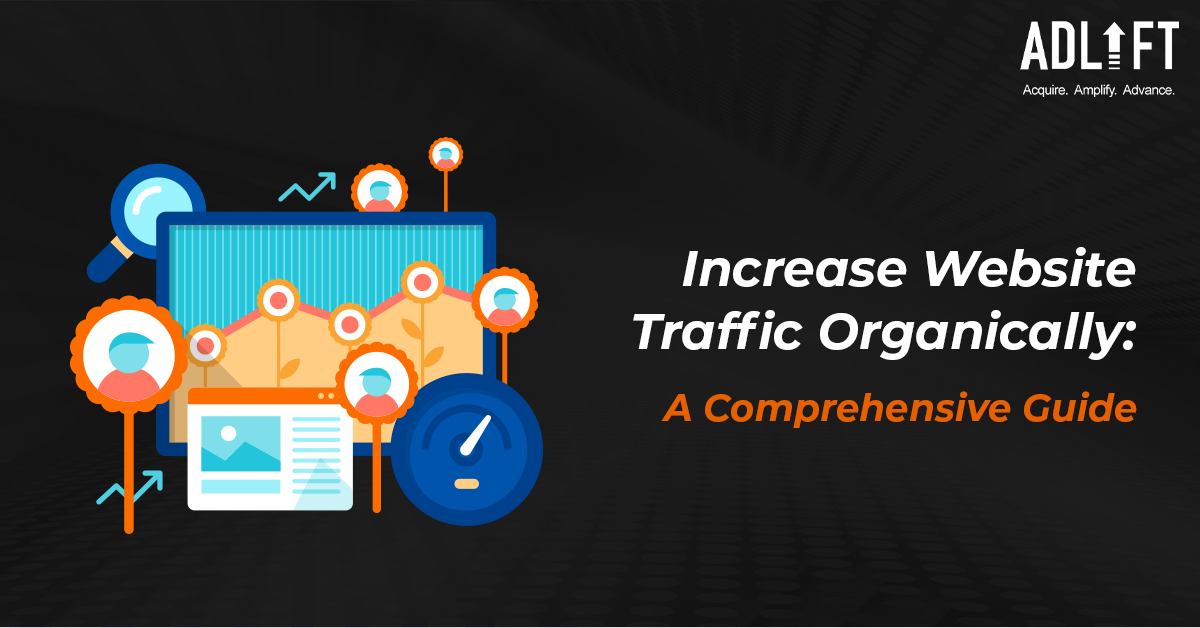Increase Website Traffic Organically: A Comprehensive Guide

For businesses with an online presence, acquiring visitors without paying for every click has become the gold standard for sustainable business growth. This pursuit to discover how to increase website traffic organically is driven by the myriad benefits organic visitors offer—higher engagement, longer time on site, and, often, better conversion rates. Through this guide, we will equip you with proven strategies to bolster your organic online presence and explain how to increase website traffic organically.
Understanding Organic Website Traffic
When we talk about how to increase website traffic organically, we’re discussing those users who stumble upon your website through an unforced method, primarily search engines, without the influence of paid promotions. These are individuals actively seeking answers, products, or services, making their visit intentional and meaningful. Grasping how to increase organic traffic on a website is fundamental as it’s a testament to your content’s relevance and value in the digital realm. The first step to understanding how to increase website traffic organically is to first learn the basics of SEO.
The Basics of SEO (Search Engine Optimization)
SEO is the science (and art) of tuning your online content to make it appealing to search engines, thus improving your visibility. The quest for “how to increase SEO traffic” entails:
- Keyword Research: Utilize tools to ascertain what potential customers are searching for, understanding their intent and language.
- Optimization: Construct your content and website layout around these identified keywords without overstuffing.
- Quality Backlinks: Accumulate links from respected websites. Search engines view these as votes of confidence in your content.
Content Creation for Organic Traffic
Content creation is an important aspect of learning how to increase website traffic organically. A robust online presence is greatly bolstered by content. But not just any content—content that resonates, informs, and engages. Delving deeper into the realm of content creation, let’s explore the crucial points in detail:
- Understand Your Audience
Fundamental to any successful content strategy is the understanding of one’s audience.
- Surveys: Distributing surveys, either through email newsletters, social media platforms, or directly on your website, can be a valuable tool. They can reveal what your audience is interested in, their pain points, preferences, and more.
- Feedback Forms: Providing a medium for visitors to leave feedback on your content gives direct insights. This can help in refining your content approach and addressing specific needs or queries.
- Analytics Tools: Tools like Google Analytics or SEMrush offer deep dives into user behavior. This includes which content pieces are popular, the time spent on pages, and the kind of content that leads to conversions. Analyzing this data can inform future content decisions, ensuring alignment with what your audience seeks.
- Craft High-Quality Content
In the digital realm, content is indeed king, but the kingdom respects quality over quantity.
- Consistency: A regular posting schedule assures your audience of new content. However, the quality mustn’t be compromised for frequency. Quality, consistent content not only establishes authority but also encourages return visits.
- Diverse Formats: While blog articles might be the backbone of many content strategies, audiences today consume a range of formats. Infographics can simplify complex data, videos can humanize your brand, and podcasts can reach on-the-go consumers. The choice of format should align with the topic and audience preferences.
- Value and Relevance: Every piece of content should serve a purpose. Whether it’s answering a query, providing a tutorial, or discussing industry trends, it must deliver value. Relevance is equally crucial; staying updated with industry changes or current events can make your content timely and pertinent.
- Promote Content Proactively:
Creating content is half the battle; ensuring it reaches the right eye is the other half.
- Social Media Platforms: Social media is indispensable for content promotion. Whether it’s a teaser, a direct link, or an infographic snippet, platforms like Facebook, Twitter, LinkedIn, and Instagram can exponentially increase content visibility.
- Engage in Discussions: Join forums, Q&A sites like Quora, or niche-specific communities. Engaging genuinely, without overt self-promotion, can position you as an industry expert. Over time, this can drive curious individuals to your content.
- Collaborations and Guest Posting: Partnering with complementary brands or influencers can introduce your content to a wider or different audience. Guest posting, on the other hand, allows you to share your expertise on another platform, with a backlink often leading readers back to your site.
On-Page SEO Optimization
On-page SEO plays a pivotal role in understanding how to increase website traffic organically. It encompasses all measures taken within the website itself. Let’s delve into these crucial elements and understand their technicalities and importance:
- Title Tags
Often the first thing users and search engines see, title tags serve as a brief introduction to what the webpage is about.
- Attention-grabbing: In a sea of search results, your title tag must stand out. Crafting compelling, unique titles can increase click-through rates.
- Keyword Optimization: Incorporating primary keywords at the beginning of the title ensures that both users and search engines recognize the relevancy of your content.
- Character Length: Ideally, title tags should be between 50-60 characters. This ensures they display properly across search engines without being truncated.
- Meta Descriptions
While not a direct ranking factor, meta descriptions influence user behavior and, thus, indirectly impact SEO.
- Compelling Copy: Think of meta descriptions as ad copy. This snippet can entice users to click on your link over others.
- Include Keywords: While search engines state they don’t use meta descriptions as a ranking factor, they use bold keywords in the descriptions, making them stand out.
- Optimal Length: Typically, keeping meta descriptions between 150-160 characters ensures they appear correctly without being cut off.
- URL Structure
A webpage’s URL offers both users and search engines a clue about the content’s topic. A well-structured URL can be a deciding factor in a user’s decision to click.
- Simplicity is Key: A concise, straightforward URL is user-friendly and more easily remembered.
- Keyword Integration: Including relevant keywords can improve search visibility and provide users with context.
- Use Hyphens for Separation: Hyphens are recognized as space separators, making URLs more readable. Avoid using underscores, spaces, or any other characters.
- Internal Linking
Strategically linking to other pages on your website provides pathways for both users and search engines.
- Enhanced User Experience: By offering related articles or resources, you keep users engaged longer, reducing bounce rates.
- Spreads Page Authority: In the SEO world, certain pages acquire “link juice” or authority. By internally linking, you distribute this authority throughout the site.
- Aids in Site Navigation: Efficient internal linking helps search engines understand site structure and hierarchy, allowing for better indexing.
- Anchor Text Selection: Use relevant anchor texts for internal links. This not only gives context to users but also provides additional hints to search engines about the linked page’s content.
Off-Page SEO Strategies
This focuses on actions outside your website boundaries.
- Building Backlinks: Collaborate, guest post, and consistently produce stellar content to gain these coveted links.
- Social Signals: Regularly post and interact on social platforms. It indirectly impacts your organic traffic.
- Guest Blogging: A twofold benefit: positions you as an industry expert and brings new eyes to your content.
Technical SEO and Website Performance
Your site’s backend mechanics play a massive role in attracting and retaining visitors.
- Mobile Optimization: With the proliferation of mobile browsing, your site must be accessible and responsive on all devices.
- Swift Load Times: A delay of a few seconds can lead to significant bounce rates. Optimize by compressing images and leveraging browser caching.
- Secure and Accessible Website: SSL certificates (leading to HTTPS rather than HTTP in your web address) are no longer optional. They ensure user data safety and improve trustworthiness.
3 SEO Pitfalls: Beware on the Path to Organic Glory!
Keyword Overload
Ditch the keyword overload!
- Stuffing is so last season; search engines frown upon it.
Fact: Google warns, “Keyword stuffing” can drag down your search ranking.
Ignoring Analytics
Don’t navigate in the dark!
- Illuminate your path with insights; analytics are your guiding light.
Fact: HubSpot reveals, “64% of marketers invest time in SEO,” emphasizing the importance of regular analysis.
Beyond Fancy Design
It’s more than looks!
- User experience is the key; fancy design alone won’t cut it.
Fact: Google’s data shows a 32% rise in bounce rate as page load time goes from 1s to 3s. Remember, a bounce means no interaction!
Conclusion
Learning how to increase website traffic organically is more akin to a marathon than a sprint. While the steps mentioned earlier provide a blueprint, the essence of success is our ability at AdLift, to stay nimble and adapt to the dynamic world of SEO. True progress comes from continuous learning, refining, and innovating.
Dive into this journey with us. At AdLift, our team’s expertise and proven strategies will guide you towards impressive organic growth. Together, we’ll see your metrics rise, breaking new records and achieving unparalleled success.
Recent Posts
- Optimizing For Google AI Overviews: What Marketers Need To Know November 19, 2024
- Google’s Latest Shake-up: November 2024 Core Update November 13, 2024
- SEO Ranking Explained: Proven Techniques to Enhance Your Website’s Traffic October 22, 2024
- The Importance of Mobile SEO Optimization: A Guide to Staying Competitive October 16, 2024
- What is Evergreen Content? Build Traffic That Never Fades October 15, 2024
- The Role of Technical SEO Elements in Enhancing Site Performance and Rankings October 10, 2024
- Customer Acquisition 101: Building a Loyal Client Base October 10, 2024
- How User Experience Directly Impacts SEO Rankings: Key Factors to Consider October 8, 2024
- Core Web Vitals and SEO: How to Optimize for a Faster Website? October 3, 2024
- What is Schema Markup? Strategies to Use it for Better SEO Performance September 16, 2024
Get
in Touch
Contact AdLift for a 360-degree marketing plan

